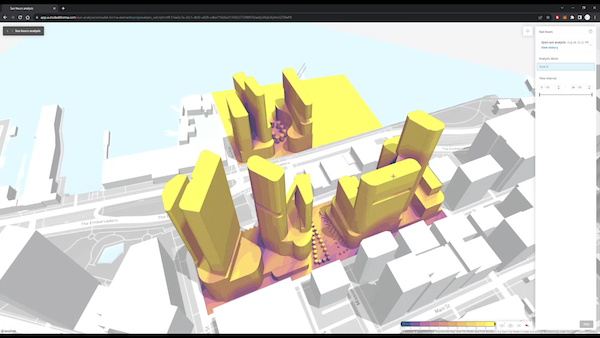
With construction project teams continually seeking to gain efficiency, some AEC firms are implementing techniques more commonly found in manufacturing. Leveraging digital technology, AEC professionals are modularizing design and construction to break projects into smaller pieces that can be reused across projects and programs.
The modular approach has been used for decades in automotive, aerospace, and other industries, but has historically found limited use in construction. Unlike cars and airplanes, most construction projects are unique, distinguished by site conditions, owner preferences, and local permitting requirements. But creative AEC professionals are finding new ways to envision and execute projects, looking for repeatable elements in large, complex projects such as data centers, multi-unit residential complexes, and nursing care facilities.
“It’s taking manufacturing ideas and applying them into construction to solve logistic and supply chain issues,” said Marty Rozmanith, AEC sales strategy director at Dassault Systèmes, the technology company that developed CATIA for the aerospace industry and now provides products and solutions across multiple industries. The modular approach can address construction industry challenges such as labor shortages and increasingly tight schedules required by owners, added Rozmanith.
Data from Multiple Sources
Dassault Systèmes’ 3D EXPERIENCE platform, a collaborative, cloud-based environment that enables data sharing, is aiding the modularization of numerous AEC projects. While often used in conjunction with CATIA, SOLIDWORKS, and other Dassault Systèmes products, the platform can also incorporate data from multiple sources and software providers. “The platform is agnostic about where the data comes from,” said Rozmanith.
Modularized design and construction often features data from multiple sources. Image source: Dassault Systèmes. Click image to enlarge.
As an example of modular design, Rozmanith cited a bathroom module incorporated into student housing complexes with multiple bathrooms. Dassault Systèmes customer Bouygues Construction imported prefabricated bathroom pods designed in SOLIDWORKS into a dormitory layout developed in Autodesk’s Revit. The bathroom components were then connected to a separate piping module developed in CATIA.
Modules such as the bathroom pod on the right can be incorporated into design models such as the dormitory layout on the left. Image source: Dassault Systèmes. Click image to enlarge.
Taking the modular concept further, AEC teams can also incorporate behavioral data into digital models to run simulations on building equipment such as plumbing and heating, ventilation, and air-conditioning (HVAC) systems. Such simulations can help determine how equipment performs under various operating conditions and help owners make operation and maintenance (O&M) decisions.
The significance of real-world simulations has led Dassault Systèmes to use the term “virtual twin” instead of “digital twin” when referring to buildings or systems that incorporate behavioral data. Whereas a digital twin is often understood to be a digital representation of a real-world entity, a virtual twin combines visualization, modeling, and simulation in a more comprehensive manner, according to Rozmanith. “A virtual twin is a virtual copy of the physical world and is predictive,” he said. “It has knowledge and context and behaves like the real system behaves.”
AEC Professionals on Board
Industry practitioners see the modular approach playing a key role in completing projects faster and more efficiently. “[AEC] is inevitably becoming more industrialized,” said John Cerone, principal at New York City-based SHoP Architects and lead technological advisor at Assembly OSM, a modular construction startup founded in 2019 by the founders of SHoP Architects. “There’s a huge amount of efficiency to be had in designing and manufacturing — to operate more like industrialized processes,” Cerone noted.
Cerone has seen the modular concept used successfully on a growing number of projects during the last decade. His first significant experience with modular design was on the Barclays Center Arena in Brooklyn, a project initiated in 2009 and completed just three years later. Without the modular approach, Cerone estimates the project would have taken five years. The project team maintained a digital approach throughout the project, from concept design to final plans, and simultaneously developed designs and exchanged information with suppliers and contractors. The team used Dassault Systèmes’ Enterprise Knowledge Language (EKL) to automate processes and “create a lot of work quickly with a small group,” said Cerone.
Since completion of the Barclays Center project, SHoP Architects has applied the modular approach on numerous other projects, such as the corporate headquarters for Atlassian, a Sydney, Australia-based software company. When completed in 2025, the 590’ -tall Atlassian tower will be the tallest commercial hybrid timber tower in the world, according to SHoP. The design, developed by SHoP and Austrailian partner BVN, features six discrete but interconnected “habitats,” with each four-level habitat a freestanding mass-timber construction supported within a steel exoskeleton. A naturally ventilated zone, akin to an outdoor garden, is located at each level.
The Atlassian tower is slated to be the tallest commercial hybrid timber tower in the world. Image source: SHoP Architects. Click image to enlarge.
The modular design of the Atlassian tower features interconnected habitats and outdoor gardens located at each level of the building. Image source: SHoP Architects. Click image to enlarge.
Other AEC professionals have seen the modular approach particularly effective on data centers and other complex projects. Alex Kunz, principal at A.G. KUNZ, a U.S.-based company that specializes in integrated design and construction, has helped clients accelerate project delivery through model-based design, analytics, and project production management.
On a recent data center project for a large technology company, Kunz’s firm was asked to help modularize designs to increase throughput and accelerate construction. “It was a very tightly integrated single facility that housed all of its functions within one facility,” said Kunz. “The scale of the cloud industry was growing so fast that they needed to build data centers faster than their existing supply chain could.”
Kunz and other project partners developed a modular system architecture, essentially disintegrating a tightly integrated system into a set of modules that could be managed independently and built more systematically. To do so, the team subdivided the project into separate systems, or sub-facilities, that could be reassembled into the overall facility. “[With data center design largely driven by power distribution], the major modular effort was in aggregating the power distribution and cooling systems to support configurability and scaling of the systems,” he said.
By grouping subsystems, the project team simplified designs and enabled components to be reused, not only on the initial facility, but across multiple projects, according to Kunz. “The key benefit in the case of the data centers comes at the program level, he said.
While working at multiple levels for clients, Kunz sees different types of digital models. At the project level, building information modeling (BIM) is commonly used to develop what’s sometimes called a design intent model. A separate production model tells the team how and when to build the product or facility of interest. And throughout the course of a project or program, integration of data from multiple sources is key. “We leverage interoperability between the design intent and the production model,” said Kunz.
Modular design typically requires multiple models at different stages of project and program development. Image source: AG KUNZ. Click image to enlarge.
Kunz’s firm, which includes mechanical engineers, architects, and software developers, has used Dassault Systèmes’ tools to drive what they call computer-aided production engineering (CAPE). The team works closely with manufacturing integrators to develop processes upstream of individual product designs. “The approach allows us to concurrently design products and their associated manufacturing and installation processes.”
In addition to using CATIA and SOLIDWORKS, the team uses Dassault Systèmes’ DELMIA to model and simulate system operations. In-house software developers build custom tools to support production management. Whether using commercial or in-house tools, the firm focuses on five levers of production management: product design, process design, capacity, inventory, and variability. “Conventional construction management is focused on schedule and cost as the weapons to control quality,” said Kunz. “We find those inevitably don't work very well, so we're focused on these five levers that are more commonly applied in aerospace and automotive industries.”
Kunz’s firm also works closely with the Project Production Institute (PPI) as part of its industry council and adopts methods from the MIT System Architecture Group to further the cause of modular design and construction. The PPI is an independent organization that seeks to improve the value that engineering and construction provide to the economy and to society. The MIT group is a member of MIT's Engineering Systems Laboratory, focused on studying the early-stage technical decisions that affect system performance.
Time will tell how modular design and construction catch on in the AEC industry. The concept is not new, but the increasing role of digital tools, such as virtual twins, interactive design review, real-time ray tracing, and other visualization improvements, may enable the approach to be used on a wider variety of projects.
Andrew G. Roe
Cadalyst contributing editor Andrew G. Roe is a registered civil engineer and president of AGR Associates. He is author of Using Visual Basic with AutoCAD, published by Autodesk Press. He can be reached at editors@cadalyst.com.
View All Articles










Share This Post